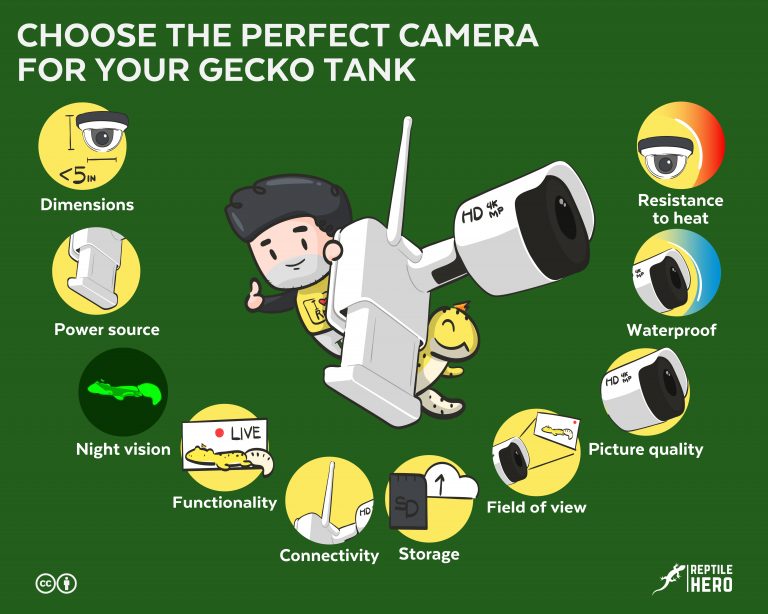How to Choose a Halogen Lamp for Your Leopard Gecko [In-Depth]
Geckos need heat lamps to keep their body temperature within healthy levels. Halogen lamps are the closest you can get to giving your leopard gecko a sun-like heat source. But once you discover how many specific types there actually are, it’s hard to choose the perfect one – that is, unless you know exactly what to look for.
As a general rule, keepers of leopard geckos consider six features when choosing a halogen lamp to ensure its compatibility with the animal’s enclosure. These factors are:
- Power Rating
- Bulb Type and Size
- Base Type and Size
- Beam Angle
- Light Appearance
- Life Span
Having halogens as reptile heat lamps are becoming the norm as they are better than most traditional heat sources we have been using. Sadly, there are persisting myths that give them a bad rep. Read until the end to find out if there is any truth to such claims!
6 Factors to Look for in Your Leopard Gecko’s Halogen Lamp
Compared to more technologically advanced and energy-efficient lighting options such as fluorescent and LED lamps, halogen does lag behind. However, in the reptile-keeping community, halogens are highly regarded heating lamps – ironically prized for their inefficiency as light sources. But not every halogen bulb can be used to keep your leopard gecko perfectly warm and cozy.
#1 – Power Rating and 4 Factors Affecting It
Generally, halogen heat lamps compatible with leopard gecko set-ups range from 30 to 100 Watts. Aside from this, keepers must also take into consideration:
- Enclosure size
- Primary tank material
- Vivarium design
- Ambient temperature
Seeing as there are halogen bulbs in the market that are quite powerful, up to 500 Watts, some of you might have mistakenly – but quite understandably – started thinking that the higher a halogen is rated for power, the better it is. Although there is some truth to the “higher power equals higher heat output” line of thinking, there’s a lot more to it than that.
Okay, sure – you definitely can simply dim high-powered halogen bulbs. However, dimming a halogen heat lamp too much will not only affect its light output but also its production of thermal (infrared) radiation [1].
| Spectral EM Radiation | Ultraviolet (C to A) | Visible (Violet to Red) | Infrared (A to C) |
| Wavelength (nanometers or nm) | 100-380 | 380-740 | 740-1000000 |
To put things into perspective: the more the dimmer of a halogen heat lamp is operated, the more its radiation curve’s peak moves to the left of the electromagnetic radiation spectrum. It moves towards visible light and ultraviolet (UV), and away from infrared radiation (IR). However, a halogen lamp’s radiation curve should ideally peak along the right side of the spectrum, producing less light and more IR or heat.
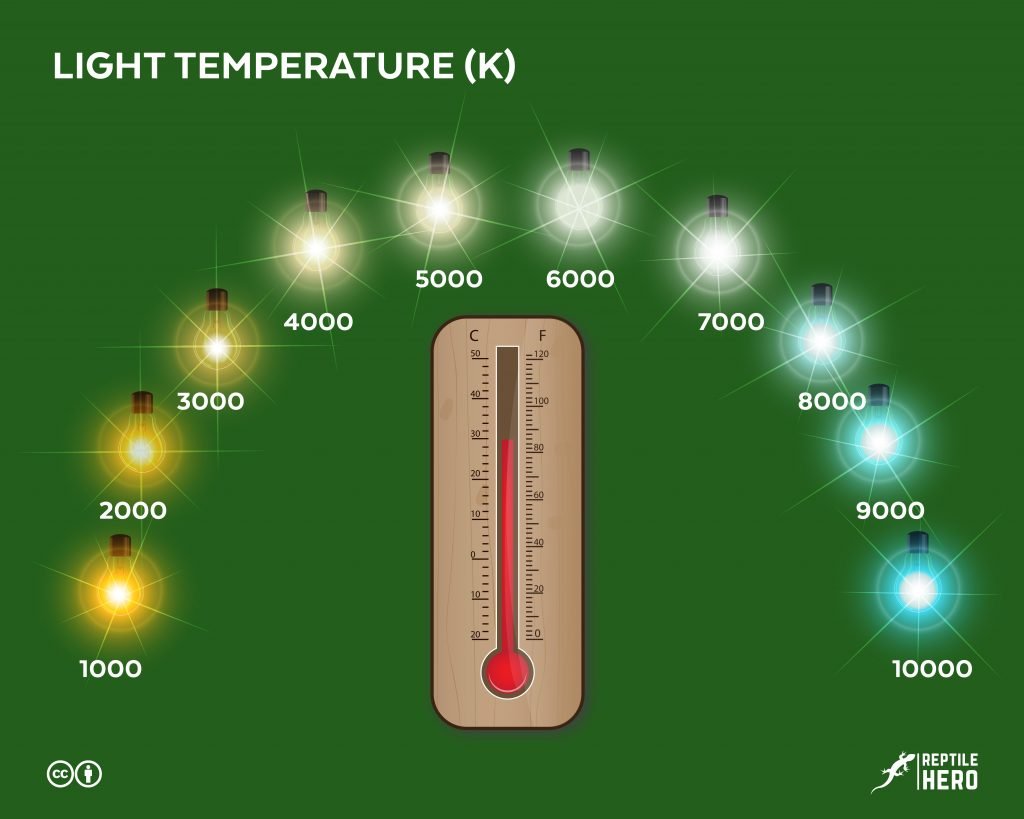
Moreover, the adorable soft-scaled geckos in our care can warm themselves up to optimal levels when the radiation peaks around the 565 nm (yellow spectrum of visible light) to the 800 nm (IR-A) range. At such points, the visible white light will have a yellowish, orangey, or reddish tint to it, which is quite noticeable out in the wild during sunrise and sunset.
Enclosure Size
The wattage of a halogen lamp is affected by the gecko enclosure’s size. Small tanks need low wattage ratings and large tanks need high wattage ratings (e.g., 20 gallons is to 30 Watts as 55 gallons is to 75 Watts).
You can use the simple table below as a general guide to finding out whether or not your halogen has enough wattage to meet your needs.
| Internal Tank Capacity (gallons or gal) | Halogen Lamp Power Rating (Watts or W) |
| 20 | 30-50 |
| 25-50 | 50-75 |
| 55+ | 75-100 |
However, as I said earlier this is not a stand-alone factor that you should keep in mind when going to find the right halogen bulb.
To be more specific, two enclosures of the same size but with different primary materials and overall design that are placed in different areas with drastically different climates are going to need halogen lamps of different power ratings.
Primary Tank Material
The gecko tank’s material can affect the rating of the halogen lamp adopted. Tanks for leopard gecko are generally made of 1) glass, 2) plastic (specifically polyvinyl chloride or PVC), and 3) wood. These materials have different capabilities in retaining heat (from glass being the worst to wood being the best).
If you have three enclosures of the same size but made predominantly out of different materials, you will have halogens of varying wattage ratings. For instance, you could use a halogen with a power rating of 70W for a 50-gallon glass tank, a 60W in a 50-gallon PVC tank, or a 50W for your 50-gallon wooden tank. Essentially, for glass, you need to go for high-powered halogens. For PVC, you should go for mid-range heat lamps. Lastly, for wood, you can settle for low-wattage bulbs.
Of course, these recommendations are not completely set in stone. So instead of going straight for the highest end of our suggested wattage range for your leopard gecko’s vivarium size and material, it’s always safest to start from the lowest end.
I have already read numerous accounts from other keepers about overspending on their halogens because they started with 100W halogen bulbs. Although they were able to maintain good temperatures for their baby’s warm side and basking spot, they were unable to get a good thermal gradient because the cool side was far too warm.
Tip for beginners
To avoid getting an undesirable temperature gradient within a leopard gecko tank, start with a halogen that has a rating on the lower end of the recommended range. You will typically find good package deals for this, so if one isn’t enough, you could add another one.
As a matter of fact, experienced keepers and experts in the field say that a cluster of two or three low-wattage halogens is better than a single high-wattage halogen when it comes to obtaining and maintaining an optimal thermal gradient. If you forgot, that’s a 70-80°F (21-27°C) cool side to an 85-90°F (29-32°C) with a 95-100°F (35-38°C) basking spot for our leos.
Vivarium design
Vivariums designed with full ceiling panels, by and large, need halogen lamps with lower wattage ratings compared to ones designed with a mesh top.
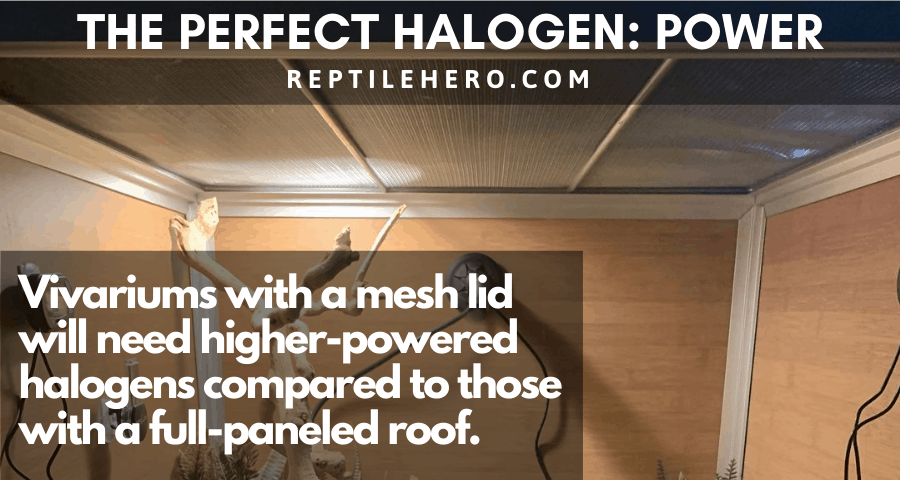
I know that a good portion of you reading this right now are thinking I’m being overly dramatic and blowing things out of proportion. But I’m being totally honest here. Though I personally haven’t experienced this, friends and acquaintances of mine who are also pet parents to leopard geckos can definitely vouch for my claim.
Using the same table for the suggested heat lamp power ratings according to tank size, you might think that a fully enclosed 120-gallon wooden vivarium with some vents would need at least one 100W halogen. At least, I know I did.
However, multiple other keepers have proven me wrong. With just a single 50W halogen, the entirety of a 4x2x2 feet (120x60x60 centimeter) tank could easily reach a steady ambient temperature of 85°F (29°C) for hours on end, causing the bulb to dim significantly within just a few minutes of use until it gets turned off.
For a 120-gallon enclosure designed with wooden wall and floor panels plus a steel screen top like this one from Zen Habitats, on the other hand, you would need at least one 75W halogen bulb to make sure that your cool side doesn’t dip below 70°F (21°C) during the day.
Ambient Temperature
The ambient temperature will affect the wattage of the halogen lamp for a leopard gecko. Leopard geckos housed in states up north (e.g., New York) will need higher wattage halogens compared to those kept in states down south (e.g., Hawaii).
For you to understand this point easier, consider the following figures in the table below. The data is based on decades worth of weather records in New York and Hawaii from the National Oceanic and Atmospheric Administration or NOAA – formerly known as the National Climatic Data Center [2]:
| Specific US State | Annual Average for Hot Days | Annual Average for Cold Days | Overall Annual Average |
| New York | High 50°F (approx. 14°C) | High 30°F (approx. 3°C) | 45°F (7°C) |
| Hawaii | High 70°F (approx. 27°C) | Mid 60°F (approx. 19°C) | 70°F (21°C) |
If I stayed in New York and had my leo housed in a 50-gallon glass enclosure with a screen top, a 75W halogen will do the job. But if a friend of mine that lives in Hawaii had a 50-gallon, full-PVC vivarium for his leopard gecko, even a 50W halogen might be too much.
However, I would like to once again emphasize that there is no single standard power rating that keepers must use. What I have shared – and will share – are a couple of suggestions based on my and many other experts’ experience. So you might have to experiment a little to find the perfect wattage for your leo’s specific set-up.
#2 – Bulb Type and Size
On average, the most widely used and tested type of halogen bulb with an internal reflector in the leopard gecko keeping community are parabolic aluminized reflector or PAR bulbs in sizes 30 and 38. However, other keepers have also used R, BR, and MR types of similar sizes.
There are numerous types of halogens bulbs you can choose from, however, not all can be used for proper leopard gecko husbandry.
| Bulb Types with Reflector | Bulb Size (Diameter in Inches) |
| Reflector or R | 12 (1 ½) 16 (2) 25 (3 ⅛) 40 (5) |
| Bulged Reflector or BR | 25 (3 ⅛) 30 (3 ¾) 38 (4 ¾) 40 (5) |
| Multifaceted Reflector or MR | 8 (1) 11 (1 ⅜) 16 (2) 20 (2 ½) |
| Parabolic Aluminized Reflector or PAR | 14 (1 ¾) 20 (2 ½) 30 (3 ¾) 38 (4 ¾) |
Included in the table above are some of the usually used halogens bulbs with internal reflectors. They are ideal heat lamps because they were made to redirect both light and heat toward one direction, in particular, depending on how they are installed.
R bulbs are the most similar in appearance to the old incandescent bulbs we are familiar with, however, they have a mirror-like coating inside the glass housing itself that acts as a reflector.
The only difference the BR types have with the former is that their internal reflective coating extends to the neck of the bulb, so you won’t be able to make out the filament inside. But the downside is that they are highly sensitive to the oils and salts we have on our skin that could damage their quartz or glass housing.
Unlike the aforementioned bulb types, MR and PAR lamps actually have a smaller halogen bulb capsule safely housed in a reflective housing. Aside from that they usually also have a thick protective glass lens which could either be clear or frosted which is critical in blocking out harmful levels of UV that the filament can produce when operating at high temperatures [3]. I recommend uncolored frosted lenses over clear ones so that light is less intense and more naturalistic.
Nevertheless, PARs are a clear favorite among keepers, breeders, and experts in the reptile community as these usually have standard bases which can be used with most commercially available fixtures and offer wider light distribution.
#3 – Base Type and Size
For the most part, PAR halogen heat lamps have an Edison screw (ES) base that is either 26 or 27 millimeters (mm) in diameter. Conversely, MR halogen bulbs are more commonly designed with bi-pin (G/GU) bases. The distance between the pins is traditionally 5.3 or 10 mm.
With a quick look around exotic pets shops, local hardware stores, and online shops, you will see that most fittings and fixtures for light bulbs have sockets that are only compatible with medium or standard ES bases. This is regardless of whether they are made especially for reptiles or for regular household use.
| Group Name | North American Size (mm) | European Size (mm) |
| Candelabra | 12 | 11 |
| Intermediate | 17 | 14 |
| Medium/Standard | 26 | 27 |
| Mogul/Goliath | 39 | 40 |
PAR bulbs usually have medium ES bases, E26 and E27 bulbs and fixtures can be used interchangeably since their difference is only 1 mm. So if you’re wondering whether or not you can use an E26 bulb with an E27, the answer is yes – you definitely can.
Now, although you can find MRs with ES bases, they are predominantly designed with GU bases which are installed by simply plugging them in or by twisting them to lock them into place. More specifically, GU5.3 bases are plug-ins while GU10 bases are twist-and-lock. However, you can find and buy adaptors to fit these into standard ES sockets.
#4 – Beam Angle
In terms of appropriate beam angle or light distribution, flood-type halogen bulbs are recommended for use in reptile husbandry over spot types. Floodlight halogens are effective in creating a naturalistic and gradual spread of heat and light in a leopard gecko’s enclosure.
Before I go on, think of sunlight. Our sun produces a virtually all-encompassing beam of light that can penetrate the depths of our oceans. I know this is impossible to recreate in captivity. But we do have something that comes close to it – floodlights.
Flood bulbs typically have about a 40° beam angle. Halogens with internal reflectors are usually floodlights, which again, is exactly why they are the heat lamp of choice in the community.
Conversely, a spot halogen that has a beam angle of approximately 20° will concentrate its energy to produce a really hot but small beam of light. With a spotlight, your precious leopard gecko could have a basking spot of over 100°F (38°C) but have lower than needed ambient temperature not only on the cool side but the warm side as well.
#5 – Light Appearance
All in all, leopard geckos will benefit from halogen heat lamps that have a color temperature of more or less 3000 K. Such halogens will have a radiation curve that peeks around the yellow, orange, red, and IR-A spectrum, giving the light a warm appearance.
Though natural daylight has a light appearance of 5000 Kelvin (K), which is cool blue-white sunlight, you do not have to hunt for a halogen lamp that has such a high color temperature because that would produce more visible light and UV but significantly less IR.
Moreover, most halogen heat lamps have a lower color temperature of 2500K to 3500K. And though they have lower temperatures, their light output is perceived as warm yellow-white light. Some even refer to the light appearance within this range – normally experienced around sunrise and sunset – as the golden light.
#6 – Life Span
In general, regular halogen heat lamps have an average life span of 1000 to 3000 hours when operated at full power – without a dimmer. This is equal to about 3 to 8 months of life when operated for an average of 13 hours a day inside a leopard gecko tank.
Some people make the mistake of taking the declared life span of a bulb in its packaging’s lighting facts as is. However, this information is calculated with only 3 hours of daily information in mind. A bulb’s life span is generally indicated in terms of years (e.g., 1.4). To find out its exact average rated life (ARL) in hours, use this simple equation:
Average rated life (hours) = life span (years) [x] 365 (days/year) [x] 3 (hours/day)
So to find out the ARL of a halogen bulb with a life span of 1.4 years, the calculation would look like this:
| Life Span (Years) | x | 365 (Days/Year) | x | 3 (Hours/Day) | = | Average Rated Life (Hours) |
| 1.4 | x | 365 | x | 3 | = | 1533 |
Then if you want to find out exactly how long that would last you, in terms of months, according to your pet’s specific daily usage time, the succeeding equations would be:
- Life span (days) = ARL (hours) [÷] usage time (hours/day)
- Life span (month) = life span (day) [÷] 30 (days/month)
Remember: a leopard gecko generally needs 12 hours of light and heat during the summer, and 14 in the winter. That’s an average of 13 hours of daytime light and heat per day.
| ARL (Hours) | ÷ | Usage Time (Hours/Day) | = | Life Span (Days) | ÷ | 30 (Days/Month) | = | Life Span (Months) |
| 1533 | ÷ | 13 | = | 117.92 | ÷ | 30 | = | 3.93 |
From this series of simple calculations, you can expect about 4 months of use with a halogen that has an ARL of 1533-hours. But you should keep in mind that this rating is normally based on the time it takes for 50% of all sample bulbs to burn out in a highly controlled laboratory setting. So you can expect a shorter or longer life than the ARL.
Other Factors that Could Shorten a Halogen’s ARL Include:
- Temperature extremes
- Exposure to high humidity levels
- Frequent switching (on/off)
- Damage to quarts housing of capsule
- Power surges
- Excessive vibration
- Degeneration of filament
- Operation at a higher voltage than recommended
- Overheating during usage
4 Simple Steps for Halogen Lamp Installation
Properly installing a halogen heat lamp inside your leopard gecko’s vivarium isn’t rocket science. However, it is totally normal for people to feel overwhelmed by such a task that is unfamiliar to them. So don’t worry, I’m here to dispel all your worries when it comes to setting up your heat lamp.
#1 – Inspect
The very first step in installing a halogen heat lamp is to ensure that the bulb, fixture, and power source are compatible with each other in terms of:
- Size. A halogen with an E26 base should have a fixture with a ceramic or porcelain socket that is E26/27. Plastic sockets are not recommended in reptile-keeping heat lamp applications as they can melt. The dome or wire cage should also be of compatible height and diameter with your halogen.
- Maximum wattage load. Double-check the maximum wattage load your fixture can handle. For instance, if you have a 100W deep dome with a dimmer switch, your bulb should have a wattage rating that is equal to or less than 100W.
- Voltage. Your bulb and fixtures should have a maximum rating of 120 V if you are in North America and 240 V if you are in Europe.
Besides that, make sure that nothing is damaged, especially the wiring in your cords/cables. Otherwise, you run the risk of electrocuting not just yourself but your beloved leo as well. Also, even though you don’t need to use work gloves when installing PAR or MR halogens, I would still advise you to use a pair for safety precautions.
#2 – Regulate
There are two main ways to regulate a light-emitting heat source, such as a halogen heat lamp, in the vivarium of a reptile pet like a leopard gecko:
- On/off switch and dimming thermostat combo. Dimming thermostats are still a rare find in the US reptile market, driving prices into the hundreds for the most basic models like the one shown below. However, having your halogen plugged into a dimming thermostat that is set to about 91-100°F (33-38°C) is a sure way to prevent your leo from experiencing a heatwave in its enclosure and becoming dehydrated – or worse, death by heat.
- Dimmer switch and on/off thermostat combo. With this arrangement, having an on/off thermostat set a few degrees higher than optimal (i.e., 104°F or 40°C in the hot spot) gives you a fail-safe. You can rest easy knowing that your leo won’t get toasted even if you are not by its tank 24/7. If the lamp does get dimmed until it shuts off, you won’t have a big issue given that you also have other lights inside (e.g., UV bulb).
A dimming switch/fixture and a dimming thermostat should not be used together. Your halogen will malfunction if you do this and even blow.
#3 – Install
In fully paneled PVC and wood enclosures with a few air vents, you will need to either install it inside as you would with ceiling lights or alter it to have a screened ceiling. For screen-topped enclosures, you can choose to go for a relatively effortless internal or external installation.
Internal Installation
Installing halogens inside a full PVC or wood enclosure’s ceiling is pretty much the same as a normal ceiling light installation at home. However, if you have never done that before I suggest that you ask for help from a friend or professional who is well-versed in electricals.
You will need the following to set up your halogen onto the vivarium ceiling:
- Safety gloves
- Wire stripper
- Screwdriver
- Mounting bracket (or electrical/junction box)
- Screws
- Power cable with switch (on/off or dimming)
- Ceramic/porcelain lamp holder (here on Amazon)
- Halogen bulb
In case you have a tall enclosure that has a screen top, you can simply screw in your halogen into a dome or cage fixture and hang that fixture with a steel chain to the mesh. Just make sure that the very bottom of the lamp is a good 12 inches (30 centimeters) away from the substrate or slate tile in your gecko’s basking spot.
External Installation
More commonly, pet parents of leopard geckos and other reptiles that are housed in enclosures with a metal mesh roof will simply purchase a dome fixture, securely mount the bulb into the socket, then finally place it right on top of the tank’s warm side.
Others would purchase a dome spring clip to minimize the movement of the halogen. Some even would go to the extent of constructing a lampstand so that the heat lamp remains undisturbed even when the tank is accessed through the movable screen lid.
#4 – Test
Once your cold-bellied leopard gecko’s halogen heat lamp is securely installed, let it run without your leopard gecko inside for two full day-night cycles to accurately determine whether it’s safe for your little one.
Don’t forget to have the power cord connected to the thermostat, which is in turn connected to a power outlet that has the dual functions of a timer and surge protector.
Regularly check the temperature in the basking spot with a contactless IR thermometer gun, as well as the ambient temperature on the cool and warm side – each their own digital thermometers.
3 Common Concerns About Halogen Lamps (and the Truth!)
Despite the increasing popularity of halogens in the reptile-keeping community, I still see quite a lot of pushback on their use. What I have noticed though, is that all the negativity, uncertainty, and hesitancy towards halogen heat lamps are commonly rooted in misconceptions and plain misinformation.
#1 – No Belly Heat
Leopard geckos won’t get their much-needed belly heat from overhead heating sources like halogen lamps. Well, at least that’s what some people seem to still believe.
The truth of the matter is that leopard geckos, much like most other reptiles, don’t absorb heat from one specific part of their bodies in total isolation.
Case in point, they are capable of absorbing heat throughout the whole length of their bodies – not just through their slightly thinner skinned bellies.
#2 – Light is Unnecessary
Contrary to popular belief, leopard geckos do bask despite being crepuscular reptiles that predominantly become active during dawn and dusk [1, 4]. So the argument against the use of halogen heat lamps as heat sources because they emit light is unfounded.
As a matter of fact, reptiles that bask – open (full) or cryptic (partial) – are known to associate the presence of light with a good basking area.
Plus, leopard geckos are crepuscular animals so they are normally active during times when light is visible albeit relatively dim.
#3 – Blindness from Exposure
Despite there being a likelihood of leopard geckos and animals in general, to become blind from exposure to both natural and artificial light sources, the chances are incredibly slim.
The light source should be of high intensity, such as a laser, and directly pointed into the eyes for a prolonged period for it to actually cause blindness. However, most living beings with eyelids, such as our cute little companions, have a considerably quick blinking response to protect our eyes from such severe damage.
Halogens are placed overhead, not directly in their line of sight, so blinding them with the use of a light-emitting heat source is possible but highly unlikely. If you have a more light-sensitive leo in your care, just provide more hides and foliage for them to seek shelter and shade under.
Takeaways
Halogens heat lamps for leopard geckos should have a power rating that falls in the 30-100W range. Finding the exact wattage right for your specific set-up will depend on 1) enclosure size, 2) primary tank material, 3) vivarium design, and 4) ambient temperature.
A halogen with an internal reflector is suitable for reptile husbandry use. PAR30 and PAR38 bulbs are the most recommended bulbs. Some experienced keepers have also used MR, R, and BR types of similar sizes.
On average halogen bulbs usually have E26, E27, GU5.3, or GU10 bases. Most household and reptile lighting fixtures in the US have sockets that are compatible with E26 and E27. For other base types, an adaptor will be needed for installation.
Floodlight halogen lamps are recommended for use because they effectively create a desirable thermal gradient for leopard geckos.
Light-emitting heat sources like halogens should have a color temperature near the 3000 K range to ensure that your leopard gecko will be exposed to IR-A radiation which they can feel as deep-penetrating heat.
Typically, a halogen lamp will have an average rated life of 1000-3000 hours or 3-8 months when operated at full power for 13 hours every day. Unfortunately, a variety of other factors, including power surges, can significantly reduce a halogen’s ARL.
Sources
[1] https://ambassadoranimalsag.files.wordpress.com/2018/09/january-2018-quarterly-newsletter-ahh.pdf
[2] https://www.ncdc.noaa.gov/
[3] https://arborviewah.com/wp-content/uploads/2021/03/Leopard-Gecko-PDF.pdf

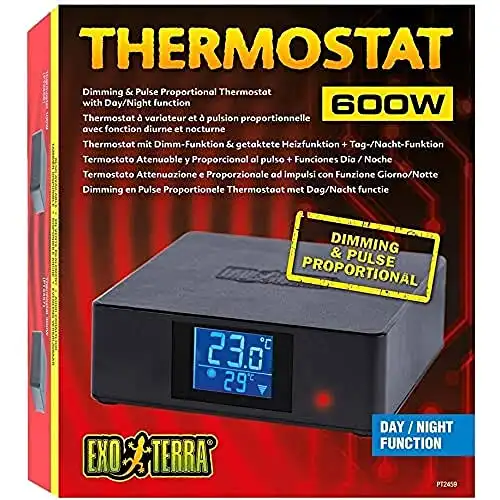
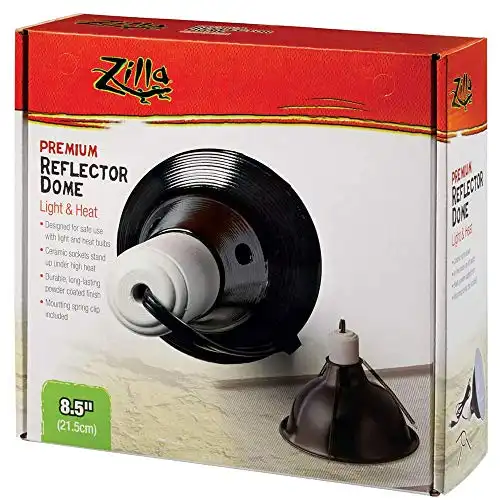
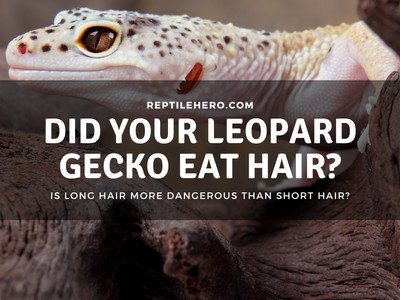
![Got a Gecko With a Bad Stuck Shed? [3 Problems and 9 Solutions]](https://www.reptilehero.com/wp-content/uploads/2021/10/Help-gecko-shed-skin-cc-768x614.jpg)
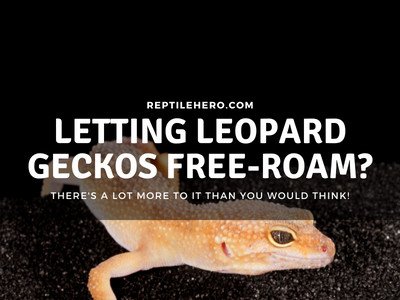
![Is House Gecko’s Bite Dangerous? [and What To Do]](https://www.reptilehero.com/wp-content/uploads/2022/05/house-lizard-bite-dangerous-cc-768x614.jpg)
![Are Red Lights Really Bad for Leopard Geckos? [Not Exactly]](https://www.reptilehero.com/wp-content/uploads/2021/11/Red-lights-on-gecko-cc-768x614.jpg)
